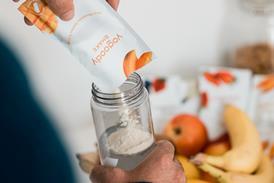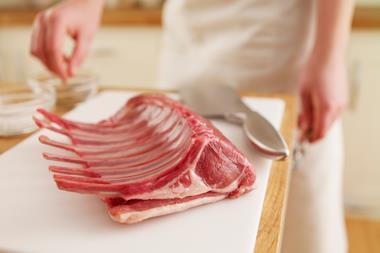Sacré bleu! A decade ago, the French would have slashed the tyres of a UK beef lorry destined for their stores, but perceptions are changing
It’s not quite on a par with delivering ice to Eskimos, but selling British meat to the French has historically been one of the more difficult marketing challenges.
Whether it’s down to a simple parochial belief that “French is best” or because of the BSE and foot and mouth scares of the 1990s and early 2000s, received wisdom has it that the average French housewife would rather choke on her pot-au-feu or navarin d’agneau than buy British meat for her family.
But this perception is increasingly outdated. Red meat exports from the UK to France are, in fact, thriving. Over the past 10 years, lamb and sheepmeat sales to France have risen by 141% in volume to reach 57,600 tonnes in 2011. A staggering quarter of all sheepmeat sold in France now comes from the UK. beef exports - although still significantly smaller - have also picked up, with volume sales to France rising from virtually nothing 10 years ago to 13,300 tonnes last year [GTIS/HMRC]. So why the viande volte-face?
Crucially, while a large proportion of British meat has traditionally been sold as highly commoditised whole carcases, producers are now increasingly selling added-value cuts into French retailers, marketing their meat directly to French shoppers and creating a loyal consumer following thanks to the use of clever branding.
Go to the E.Leclerc superstore in Villeparisi on the outskirts of Paris, for example, and the most eye-catching part of the fresh meat section is a special bay promoting English lamb under the name ‘Agneau St George’, complete with a red and white St George’s Cross.
“The UK has a difficult reputational problem on beef - people have long memories, so there is work to be done”
Peter Hardwick, Eblex
The St George brand is the brainchild of English beef and lamb levy body Eblex, which launched it back in 2002 to boost exports of lamb to France. Ten years on, the brand is stocked by all major French supermarket chains, where it is supported by plenty of PoS material and in-store activity, such as cookery demonstrations, to raise awareness among French consumers.
Thierry Khelifi, head butcher at E.Leclerc Villeparisi, says the approach is working well. St George lamb is the only non-French lamb he has chosen to stock, and following a recent in-store demonstration for St George, his store sold the equivalent of 20 carcasses of English lamb in two days, compared with typical weekly sales - of French and English lamb combined - of between 12 and 15 carcasses.
What attracts French shoppers to the brand? The fact English lamb is about 15% cheaper at retail than French lamb certainly helps, says Khelifi, but he insists there’s more to the success of St George than price. The brand presents a “green meadow” image of the UK and highlights the fact its lamb is quality assured.
In a market where most own-label meat packs are rather plain, the colourful St George branding and packaging creates real stand-out on shelf, he adds. “The packaging is very attractive and customers are getting into a habit of seeing the St George brand in Leclerc stores, and they remember it. Price is important, but it is not the only factor for our customers.”
Neither is it the way to forge lasting consumer loyalty, says Eblex head of trade development Peter Hardwick, which is why Eblex decided to go down the branding route with St George in the first place. If low price were the only selling point, producers would be vulnerable to a collapse in export sales when prices went up, as they have recently on lamb, he says. “The St George brand and its quality message have allowed us to maintain a loyal consumer base, despite sharply rising prices, and helped us protect our export market.”
St George is currently used only for lamb at retail, but Hardwick says the brand has proved such a success that Eblex is looking to extend it to English beef. This won’t be easy. Unlike lamb, English beef isn’t cheaper than its French counterpart (it is often more expensive), and it also tends to be more directly associated than lamb with BSE and foot and mouth. “Let’s be honest, the UK has a difficult reputational problem on beef that we never had on sheepmeat,” says Hardwick. “People have long memories, so there is work to be done, but I believe the St George brand is strong enough to do this for us.”
By George!
History: Eblex launched the St George brand in 2002 to boost added-value sheepmeat exports from the UK to France
Distribution: The brand is now stocked by E.Leclerc, Carrefour, Auchan, Casino and Système in about 300 stores across France some St George lamb is also sold in the Benelux countries
Collaboration: Eblex is currently working with the French lamb industry on a wider campaign, , to promote lamb to younger French consumers
What’s next: It plans to extend the brand to beef in the next year
High-end butchers
Away from the mainstream supermarkets, English, or more accurately British, beef is already proving its potential to impress even the most discerning of French palates. Some of the country’s leading butchers are now selling beef from the UK as a premium delicacy to their well-heeled Parisian clientele, and they are effusive about the consistent quality and sophisticated flavour profile of le boeuf Anglais.
“I really like British beef for the quality and the taste - it is always tender,” says Jean-Christophe Prosper, who sells a wide range of beef cuts, as well as lamb, from the UK in his shop in Montmartre.
Selling UK beef in France can be a challenge, Prosper admits, but his customers are increasingly developing a taste for dry aged beef - “a concept really introduced to France by the British” - and are prepared to pay a premium for high-quality British fare. “It is now very easy to sell British beef and lamb in France,” says Prosper. “People are better travelled and more adventurous, and Marks & Spencer being back in France has also helped. It all highlights British products that stand for quality and a certain British lifestyle.”
It’s a similar story at Boucherie Lamartine, the posh butcher’s shop run by celebrity butcher Yves-Marie Le Bourdonnec, where beef and pork from Ginger Pig founder Tim Wilson are proudly displayed in gleaming glass cabinets. “People buy British because of the great consistency of the product, whereas French beef can be far more variable,” says one of Le Bourdonnec’s butchers, who adds the rib of beef is currently the shop’s most popular British product.
Strikingly, both butchers are very clear in labelling their meat as British - some of the in-store signs used by Prosper are entirely in English, while meat labels at Boucherie Lamartine read “long-horn de chez Tim Wilson” - leaving their clientele in no doubt about the provenance of their meat.
With the high end of the French market now waking up to the benefits of British beef, Eblex is busy preparing its French supermarket partners for the arrival of St George-branded beef. Hardwick is confident a launch will get underway within the next 12 months, and Khelifi at E.Leclerc Villeparisi is certainly open to the idea of stocking St George-branded beef once it becomes available. “We have had good experience with St George lamb, so why not?” he says.
Eblex’s aspirations don’t end with France. It also has its eye on the biggest European market of them all - Germany. Hardwick says it’s early days, but he is hoping to get branded English lamb onto German supermarket shelves within a year, possibly under the name Royal Lamb, but is tight-lipped on details for now.
The German economy is still going strong despite the troubles of the Eurozone, so livestock exporters will be hoping the St George brand is translated from French into German sooner rather than later - and then perhaps into a few other languages too.



















No comments yet